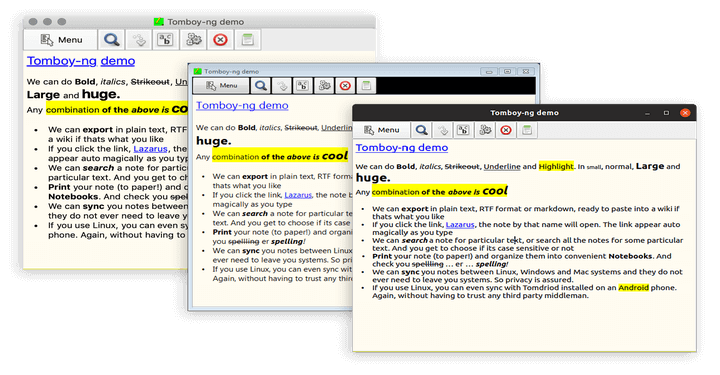tomboy-ng – Simple Note-Taking Application for Desktops



tomboy-ng is a free and open-source note-taking application for Linux, Mac, and Windows desktops. It is built with simplicity in mind which makes it easy to use for organizing different ideas and managing notes using typical note-taking features such as rich text markup, spell check, printing, import and export, MarkDown editing, and backup recovery.
tomboy-ng is a fork of the now-discontinued note-taking app, Tomboy, whose best ‘selling point‘ was its ability to relate notes together thanks to its WikiWiki-like linking system. All you need to do in order to digitize your idea in an organized manner is to type a name. When you press the link button, tomboy-ng create a branch of the main idea, and all branches (as links) won’t break even when you rename or reorganize them.
-

- Login or register to post comments
 Printer-friendly version
Printer-friendly version- 2608 reads
 PDF version
PDF version
More in Tux Machines
- Highlights
- Front Page
- Latest Headlines
- Archive
- Recent comments
- All-Time Popular Stories
- Hot Topics
- New Members
digiKam 7.7.0 is released
After three months of active maintenance and another bug triage, the digiKam team is proud to present version 7.7.0 of its open source digital photo manager. See below the list of most important features coming with this release.
|
Dilution and Misuse of the "Linux" Brand
|
Samsung, Red Hat to Work on Linux Drivers for Future Tech
The metaverse is expected to uproot system design as we know it, and Samsung is one of many hardware vendors re-imagining data center infrastructure in preparation for a parallel 3D world.
Samsung is working on new memory technologies that provide faster bandwidth inside hardware for data to travel between CPUs, storage and other computing resources. The company also announced it was partnering with Red Hat to ensure these technologies have Linux compatibility.
|
today's howtos
|









.svg_.png)
 Content (where original) is available under CC-BY-SA, copyrighted by original author/s.
Content (where original) is available under CC-BY-SA, copyrighted by original author/s.

3 plain text note-taking tools
3 plain text note-taking tools